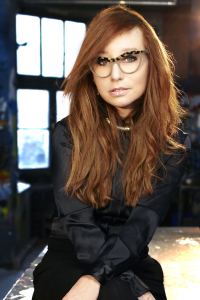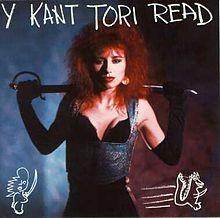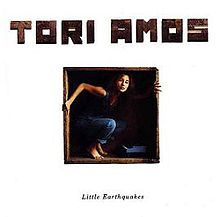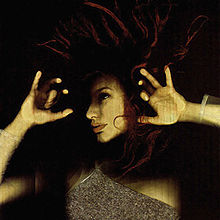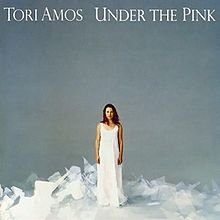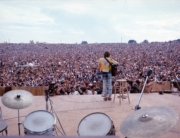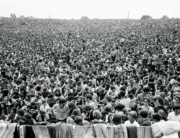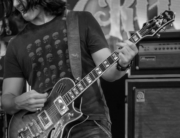BY MIKE METTLER — APRIL 29, 2015
Tori Amos has always been an artist who knows what she wants, and knows how to get it. “Music was always first,” she says. “The records you hear, whether you like them or not, you can blame me for, because I was fighting all the time that the songs were represented in the right way.” For Tori, the “right way” meant staying true to the core of her quite personal songwriting, piano-driven arrangements, and unique vocal character, all of which are on fine display on the just-issued two-disc Deluxe Editions of 1992’s Little Earthquakes (1992) and 1994’s Under the Pink (both on Rhino). Songs like Earthquakes‘ emotionally raw bookends “Crucify” and “Silent All These Years” and Pink‘s drolly dramatic “Pretty Good Year” and hard-charging “Cornflake Girl” show Amos’ conviction for how best to get across her artistic message. “I’ve taken a pretty firm stand about being a woman in control of my destiny — for good or ill, you know?” she admits. “People know that I fight for the art, and the music. I’m not going to back down.” That unbridled spirit is also well in evidence on her most recent studio project, 2014’s Unrepentant Geraldines (Mercury Classics).
Here, Amos, 51, and I discuss the hard-fought genesis of Earthquakes and Pink, how her sound-quality goals shifted in the transition from the ’80s to the ’90s, and how she forged her artistic identity. She may have once been everybody else’s girl, but today, she’s her own. You bet your life she is.
Mike Mettler: I have to say, it’s been quite satisfying to revisit the legacy of both Little Earthquakes and Under the Pink all these years later to see just how well they hold up.
Tori Amos: It’s been enjoyable. Jon Astley remastered them. We made a complete representation of the time, adding the B-sides and some live performances from that time to make it an honest time capsule.
Mettler: I like that phrase, “honest time capsule.” In terms of the sonic qualities of Little Earthquakes, which took a number of years for you to get together, what was your overall intent for how you wanted this record to sound? What was most important?
Amos: Well, we were coming out of the ’80s, which, as you know, had a lot of experimenting going on from the electronic side of things. Synthesizers really were being explored in all kinds of ways. For quite a long time, they replaced pianos, Hammonds, Rhodes — even though sampled Rhodes started to happen, and things like that.
Mettler: With the Fairlight, and all that kind of stuff.
Amos: Yeah, all that stuff. Oberheim [synthesizers] and the Yamaha DX7 [digital synthesizer] started to come into being. From the technical side, all of my demos were made on a [TASCAM] Portastudio. I’d been working with that since I was a teenager. Everybody had a Portastudio in L.A. at the time, producing their own stuff with their own drum machine. A lot of things started out that way.
In ’88 or ’89, after Y Kant Tori Read [Amos’ ’80s synth-pop band that released an ill-fated self-titled album in 1988], I started to move things over to a Yamaha CP80 [electro-acoustic grand piano], which Eric Rosse, who I was working with on the demos, had. And then I got an upright piano, and started to realize a lot of things needed to be tracked on the piano. When [co-producer] Davitt Sigerson got involved with Little Earthquakes, he felt that acoustic piano needed to be the center. When he was producing, that was very much what was going on.
Mettler: I agree that having your piano at the center of the arrangements gave those songs additional weight. In general, your albums are known for having a high standard of sound quality, which we audiophiles really appreciate.
Amos: Thank you. People who are audiophiles — I welcome them, because that excites me. In the studio, we’re checking things on the PMCs [studio monitors] and then we switch over to the Genelecs. So I’m open to audiophiles and people who love high-quality sound — those who really care about the sound. And then you realize, too, though, that sometimes people are listening to their boxy little speakers on their computers. That’s how some people are choosing to listen to music. You have to say to yourself, “Well, we still have to be able to breathe when we’re coming out of the different forms that people listen to.”
In the early and mid ’90s, a lot of people would listen in their cars. We would make sure we were checking our mixes in the car, making sure we were aware if the speakers were hyping the bass. I don’t usually check records in the car anymore. Instead, I’m checking them on different sets of headphones, being cautious that if a certain make of headphone is boosting something, then we have to go back to the PMCs, which are sometime vicious — vicious as in, naked. You really need to hear what’s coming out of the speakers. You hear what music you’re making, without the hype of a certain type of speaker or headphone.
Mettler: What was the reaction to Little Earthquakes the first time you played it for other people?
Amos: [Co-chairman and co-CEO of the Atlantic Recording Group] Doug Morris, his first reaction was, he didn’t get it. People had advised him to take all the pianos off and put electric guitars on.
Mettler: Well, that wasn’t going to work for this music.
Amos: No. But to his credit, he and I had a long conversation, just the two of us, and we cut a deal. If I would turn in four more songs that had more production on them — with the piano not being the center but them being more synth-based — then we would talk again. Fair enough. So I had four tunes, which were “Precious Things,” “Girl,” “Tear in Your Hand,” and “Little Earthquakes.” He had since gotten the original [intent], but we both agreed by then that we couldn’t turn back, so these songs became part of the next step of the album.
Mettler: Right from the outset of the record, “Crucify” is the perfect template and statement for you as an artist and how the record is going to sound. The emotionality comes from you, the piano, and the lyrics all working together. Without capturing it that way, a lot of it might have been lost.
Amos: You’re right. This is before the Internet, so I think it’s difficult for people now, growing up in a world where piano is much a part of the palette in commercial records, to understand how you had to get signed by a record label, really, to get out there. An acoustic piano was not something A&R guys or record heads felt would be embraced by the commercial market. They felt that it was left behind in the ’70s with Elton John, Billy Joel, Carole King, and all that.
Nothing against those people, but they were superstars, and it’s very different when you have Elton and Billy touring in the early ’90s, and you’ve also got the grunge movement happening. It was very different to try to fit in with the grunge movement. You’ve got Mother Love Bone, Pearl Jam, and Nirvana, and you’ve also got PJ Harvey and Bjork — and then I turn in this record. They did not feel that it was fitting in anywhere, so Doug had to be very brave. He looked me in the eye after I had turned those next four songs in and said, “Ok then. If you’re going to do this, then we need to make sure somebody is really the quarterback of this record. There needs to be somebody on the day-to-day who we feel will get it.” He believed it needed to be somebody from the European side. The reason this is important is that’s when he brought in the head of East West, their sister label in England. He said if Max [Hole, East West’s managing director] gets it, we need to bring him in as part of the think tank.
When Max did come into the picture and in the frame, he felt a lot of the songs needed to be remixed. A lot of them were, and I don’t think that hurt them. He brought in Jon Kelly, who had worked with Kate Bush, and a few other people, like Ross Cullum, a British remixer, and Ian Stanley, who had worked with Tears for Fears. Ian came in and did a version of “Crucify,” that was the single, not necessarily the album version.
The next stage began to happen with the album with Max’s stamp on it, which is how you hear it today. And I would say to you that it was Doug Morris and Max Hole who embraced it and said, “Ok, we’re going to stand behind you all the way, but you have to be able to deliver this live!” (laughs) “And you have to do it all on your own, because we can’t afford to get a band behind you for this.” And I said, “Oh, I can do this by myself. I’ve been playing clubs since I was 13.” If those guys hadn’t supported it, this music probably would have been lost.
Mettler: I’m glad you got their support, then, because Little Earthquakes sounds like what you wanted it to be, where you were able to juxtapose the character of your voice and the piano in the studio, and how it all came across in the final mix. In some cases, there aren’t even any effects on your vocals at all, like the a cappella stuff with “Me and a Gun.” But occasionally, you have an echo on a line like “Where I stand” in “Silent All These Years,” which is kind of stark and drives the point home even more. Did you make the choice as to how your vocals had effects or no effects?
Amos: We were in conversation about it. I played live for Max, and he sort of demanded that before he’d take it onboard. He believed the mixes had to represent what I could deliver live. They had a little more sparkle to them. I mean, there is compression on the record and they did use electronics, but in a way that didn’t overshadow the performance.
Mettler: That’s key, because if your character doesn’t come through on these songs, a lot of the subject matter wouldn’t have the right impact.
Amos: That’s correct. It’s a very different record than, say, [From the] Choirgirl Hotel (1998), which was very much about an electronic phase I was going through. Effects became an instrument for that record. But again, that was a different time. That was breaking away from this [style], and doing something different.
But to put yourself out there for the first time as far as the world was concerned — because Y Kant Tori Read didn’t matter to most people — it was an agreed upon decision that I had to be able to deliver live what you were hearing on the record [Earthquakes], and it couldn’t be that far apart.
Mettler: Some of the live tracks you include on the bonus disc shows that template, and just how you delivered it exactly. You can feel that throughline.
Amos: I guess to compare it to the records you have today that are very produced — you just had somebody sit at an instrument and sing, without any kind of backing vocals and without any kind of lip-sync going on. The idea 20-some years ago was you had to go up with a piano or a guitar in a little club, and that’s all you are going to get. So we had to make sure that if people had heard the record and they came to see it, they couldn’t go, “What happened here? Clearly, this was a studio production.”
Mettler: Right, the live show had to be an honest reflection of what they heard on the album.
Amos: Exactly.
Mettler: How about vinyl — will these records also get a vinyl reissue?
Amos: Oh, yes. We did [Unrepentant] Geraldines (2014) vinyl, and we’ve been doing vinyl over the last few projects because we love it. It’s really important to us. [Both 2015 remastered versions of Earthquakes and Pink are available on 180-gram vinyl from Rhino.]
Mettler: Speaking of that, what is it about vinyl that you like yourself?
Amos: Well, you know, it adds a quality to the work. It’s just another layer. I find it really beautiful to listen to. It’s nostalgic for me, because I grew up listening to vinyl. That was my first way in to all my favorite records.
Mettler: What would be the first record you ever got, and what would be your favorite?
Amos: One of my favorites is probably [Led] Zeppelin II (1969). I would go from many different styles, just to listen to how people made records — you know, Joni Mitchell, Blue (1971), to The Beatles, Abbey Road (1969). There were many different records that I would listen to in those days.
Mettler: I can see that research pay off in your own work. Now I want to get into Under the Pink. Would you say there was a conscious shift in the production style and the way the songs are presented, because there is a little more guitar going on there, like the solo on “Cornflake Girl”? Was that a deliberate call for you?
Amos: Yeah, it was. I called up my friend Steve Caton, who I’d worked with in the ’80s, and, I guess, because of the success of Little Earthquakes, I had to stand firm. It wasn’t as if Max or Doug were the ones strong-arming me. As an artist at that time, if you were having success, the first thing people were talking about, even the journalists — they’d ask, “So what big producer are you going to work with now?”, because it was just a path you would take.
There was something in me that was realizing I needed to be open to learning and I needed to find my independence, even though I’m always independent on a team of people. I’m never a person who’s doing everything; that’s not my gift. I think my gift is delegating, and bringing people together. That’s what I thought a really good producer does — bringing in people, and delegating.
At the time, there were producers who I’d heard of and met, and I realized they held the power. I understood that there was very much a boys’ club in the music industry. I mean, I adore men — straight, gay; I love them. But I felt like, “I’m not going to be dependent on anybody.” I will depend on my team, but I don’t think it’s, “Please make something of me” or I’m a lost little lamb in the woods — fuck that. I felt like, “Ok, I need to learn, I need to be open.” I’m never going to be dependent on some producer who can reject me. I realized I’m never going to be part of the boys’ club. It’s never going to happen, so why try? Make your own club. Find your own boys, and bring them in. And women too.
Mettler: And maybe even the “Cornflake Guy.” (both chuckle)
Amos: Yeah, maybe. But it was really about realizing at the time, there were very few female producers — there are more now. At that time, to have power as an artist and a woman, and to own my own publishing — which I need to thank my parents for — it was very unusual. And so it meant that nobody could, say, take my songs and put them in a commercial that would misrepresent them.
The records you hear, whether you like them or not, you can blame me for, because I was fighting all the time that the songs were represented in the right way. Music was always first.
Mettler: Having your name on these records is like the seal of approval. We know we’re getting your words, your voice, your sound. And good on you for re-embracing the grunge spirits with your haunting “Smells Like Teen Spirit” cover [one of the bonus tracks on Earthquakes, which originally appeared on the 1992 Crucify EP], something we’ve talked about before.
Amos: Yeah, thanks for that. Over the years, sometimes you sit back and you think, “Maybe if I had been a little bit more warm and fuzzy to those in the industry, certain opportunities might have happened.” But on the other hand, I’ve had a lot of other opportunities because I’ve taken a pretty firm stand about being a woman in control of my destiny — for good or ill, you know? People know that I fight for the art, and the music. I’m not going to back down. If I’m wrong, I’ll back down. But I’m not going to back down.
Mettler: That’s another cover you can do: “I Won’t Back Down.” You have artistic integrity, and we really appreciate that.
Amos: Well, thank you. I hope people can enjoy these records, because they are of a time. I became a mom before I was married, trying to figure out who I was — not who your family and your friends want you to be, but who you want to be as an artist as well. That can be a very difficult time. And these records are really about that time.
Tags: audiophile, Cornflake Girl, Crucify, Davitt Sigerson, Doug Morris, Eric Rosse, From the Choirgirl Hotel, Ian Stanley, Jon Astley, Jon Kelly, Led Zeppelin II, Little Earthquakes, LP, Max Hole, Me and a Gun, Oberheim, Portastudio, Ross Cullum, Silent All These Years, Steve Caton, Tori Amos, Under the Pink, Unrepentant Geraldines, vinyl, Y Kant Tori Read

